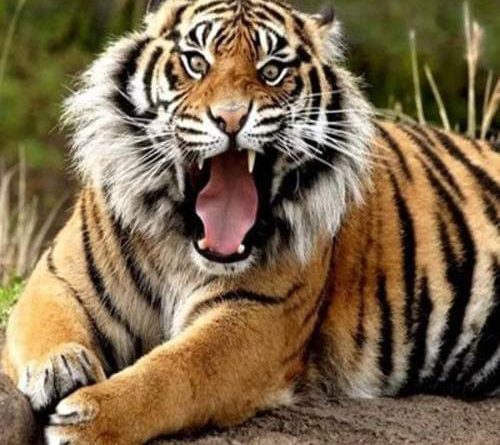Tigers: History and Significance, by Kelechi Deca
Tigers: History and Significance, by Kelechi Deca
Yesterday, July 29th was the International Tiger’s Day, set aside to focus on the conservation and knowledge sharing of ways and means of protecting this majestic creature that rules over the jungle.
This year’s theme ‘History And Significance is a follow up of last year’s which was “Their Lives Are In Our Hands’.
About 70% of existing tiger population are in India, little wonder the Tiger is India’s national animal. The ban on the killing and selling of tiger’s skin has helped in no small way in protecting the tiger population.
READ ALSO: N109bn Fraud: How Suspended AGF Idris, Compromised TSA, GIFMIS, IPPIS, for Personal Gains
In fact, back in 2016, World Wildlife Fund (WWF) declared the tiger population in India to have risen dramatically. Other countries are enjoined to copy the Indian template.
The largest among the big four (Tiger, Lion, Jaguar and Leopard), full grown male Tigers weighs up to 300 kilograms.
This enormous weight gives the Tiger undue advantage in hunting down and snuffing life out of its preys. Of all the big cats, the tiger has the second highest bite force after the Jaguar (a Jaguar’s single bite can crack the skull of a big prey like the Caiman), but a Tiger’s bite has enough force to asphyxiate a prey within seconds.
Aside its effective bite force, the paw of a Tiger is as lethal as its bite. Experts claim that one swipe from a Tiger’s front hand is enough to kill a person or an animal, or at least break one’s bones.
This was even demonstrated when a Lion breaks barricades in a Zoo (I think) in Thailand to enter a Tiger’s zone, the Tiger gave it a single hit with the paw which sent the Lion’s skull cracking and a hemorrhage ensued leading to death. That is a pointer to how strong they are. Tigers can live up to 20 to 25 years whether they are kept in captivity or in the wild.
Tigers are solitary cats, unlike the Lions that are social animals and live together in Prides, a group of Tigers is a very unusual occurrence, but where it happens, they are referred to as an Ambush of Tigers.
One reason while the Tiger population has not grown as should be in many places is very high incidence of infanticide. Like all big cats, males go about killing cubs that are not theirs just to force the lactating female into ovulation and possible mating.
Another major reason is the Tiger Mum phenomenon. Tiger Mums deploy tough love techniques in raising their cubs. They push them beyond normal, and because Tiger cubs are born blind, many do not survive these early stages of struggle which makes it difficult to breastfeed and follow their mothers as it is through the mother’s scent that they can decipher where she is going.
Tiger Mums do not pamper their cubs, maybe this is how evolution made them to adapt to their solitary nature. This is unlike Lions that have communal babysitting responsibilities where a cub can suck the breast of another lioness other than its mother, and cubs are treated as treasured eggs.
This probably gave rise to the concept of Tiger parenting which is prevalent in Asia. This is a form of strict parenting, whereby parents are highly invested in ensuring their children’s success pushing their children to attain high levels of academic achievement or success in high-status extracurricular activities such as music or sports.
The term “tiger mother” (“tiger mom”) was coined by Yale Law School professor Amy Chua in her 2011 memoir Battle Hymn of the Tiger Mother. A largely Chinese-American concept, the term draws parallels to strict parenting styles ostensibly common to households in East Asia, South Asia, and Southeast Asia.
The Tiger parent is analogous to other authoritarian parenting stereotypes, such as the American stage mother, the Japanese kyōiku mama, and the Jewish mother (those ones that solve difficult mathematical equations during pregnancy because they believe it helps improve the IQ of their fetuses ). Other similar or related terms include helicopter parent, monster parents, and Hong Kong Kids phenomenon.
Interestingly, there is an opposite parenting type known as the Elephant Mum which refers to a parent who is very nurturing and protective and tends to focus more on the emotions, emotional intelligence of the child over academic or athletic success.
Like the Jaguar, and unlike the Lion, Tigers are great swimmers, they love to swim and can spend hours in the water, some can swim as far as 25 kilometers, they are also effective under water killers like the Jaguar.
I think this ability to swim is a sign of great adaptation, being native of Asia where series of Monsoon induced rainfall leads to massive flooding of both forests and human habitations, these majestic cats might have adapted to swimming to survive.
A very unique aspect of Tiger’s physiology is that they have antiseptic saliva, which is probably why their bruises get healed faster than that of other animals, and this might also be the reason they survive most of their brutal fights because they lick their wounds to prevent infection.
It is said that a Leopard never change its spots. That is true in that the spots are not superficial, they are skin deep, if you shave off their furs, you will still see the spots. In similar vein, a Tiger’s stripes are equally found on their skin, and like no two human beings have the same fingerprints, same way, no two tigers have the same type of stripes, same goes for leopards, Zebras and Giraffes, it seems that their DNA coding is represented by these uniqueness are not easily deciphered by humans.
There are some marked differences between the tiger and other big cats. Male tigers are referred as complete gentlemen because of certain gentlemanly attitude they exhibit during the short periods they stay with female tiger.
Unlike the lions that always eat first and let the females and the cubs to eat the leftovers of the prey, tigers are more considerate. They simply let the females and their cubs to eat as much as they need while they’re waiting their turn.
Also, unlike other cats, Tigers have round pupils while all the other cats that have slitted pupils which allow the iris to contract and expand more. This is because other cats are nocturnal whereas tigers are crepuscular – they hunt primarily in the morning and evening, but despite the fact that they are not adapted to the dark, their vision is still six times better than humans’ vision.
Tiger’s high level of intelligence is demonstrated in their capability to imitate the call of other animals. Being ambush predators, they hunt by mimicry, and by that, they can lure a prey closer to where they are camouflaged as they easily blend into the forest colours.
Another very interesting aspect of the Tiger is the nature of the male’s penis which does not experience erection when aroused. Experts say the reason behind this is that its internal extra-skeletal baculum or a penis bone does all the work.
The Baculum results best in sexual procreation and it provides the male with the ability to lock the process mid-sex and prevent a female to mate with others before his sperm completely gets absorbed. This locking process is similar to that of the dog.
There used to be about eight subspecies of tigers, but today we have only five subspecies namely; the Siberian, Sumatran, the Great Bengal, South China and Indochinese. ; The extinct three species are Javan, Bali, and Caspian.
Every animal that God created has an important role to play within its given ecosystem, our very existence may depend of that singular role.
What a significant creature.




